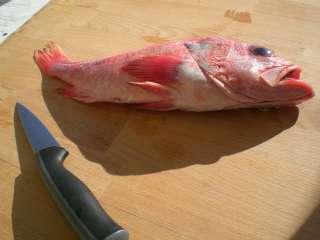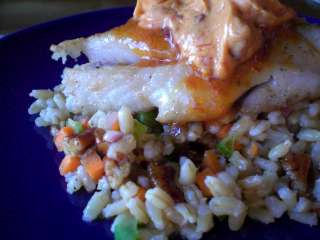How To Slay
There is almost nothing that the internet cannot teach. Want to learn how to play guitar? lose weight? speak elvish? repair a barbeque? prune a tree? drive a stick shift? cook a hot dog using LED lights? In my case, I take advantage of this all-knowing, all-seeing, teacher to learn about cooking and, most recently, how to clean and filet a fish.
On purpose, we recently bought a whole, uncleaned pacific red snapper at the market. When the seafood counter lady asked us if we wanted it cleaned and scaled and we said “No, we want to learn how to do it”, she gave us a funny look. Why wouldn’t we want her to take care of the messy parts, with the proper fish-innard-specific impelements that she had, rather than take it home whole and clumsily use the internet to guide us through the process using makeshift tools? Now, we have learned that the answer to the cleaning and scaling question is “yes, thank-you”.
At any rate, we took him home and decided to turn him into Pan-Fried Red Snapper with Chipotle Butter on Pecan Barley Salad. As so often happens, I was the one designated to do the ruthless work involving seafood; previously, I was the one who lost the coin toss and had to slay a live lobster with a chef’s knife before it got sauteed. Though this snapper was dead, and had been for awhile, he still resembled the swimming creature he once was. My first step was to wave him around in the sink for while, playing with the fins and gills and determining how he might once have moved. Then one of the spiky fins jabbed me and I lost interest in playing and was more motivated to filet him.
 After some initial searching online, this project divided itself into two parts: 1) scaling & cleaning, and 2) boning (shouldn’t it be “de-boning”?). I’m impressed with how many people have taken the time to publish the directions on how to do the first bit, and I found a great one, with pictures, on ehow. The bit about “slitting from gills to vent” was a little vague considering my knowledge of fish anatomy is also quite lean, but the internet once again helped me solve that problem (and provided a brief description of what a fish is, in case that, too, was beyond my scope: “Fish are animals that are cold-blooded, have fins and a backbone”). After making a mess using the back of a knife to scale the fish in the sink, and then having to use a surprising amount of effort to ‘slit from gills to vent’, I closed my eyes and dug around in there to get all the squishy bits out. Marc could barely watch. Sammy watched with great interest.
After some initial searching online, this project divided itself into two parts: 1) scaling & cleaning, and 2) boning (shouldn’t it be “de-boning”?). I’m impressed with how many people have taken the time to publish the directions on how to do the first bit, and I found a great one, with pictures, on ehow. The bit about “slitting from gills to vent” was a little vague considering my knowledge of fish anatomy is also quite lean, but the internet once again helped me solve that problem (and provided a brief description of what a fish is, in case that, too, was beyond my scope: “Fish are animals that are cold-blooded, have fins and a backbone”). After making a mess using the back of a knife to scale the fish in the sink, and then having to use a surprising amount of effort to ‘slit from gills to vent’, I closed my eyes and dug around in there to get all the squishy bits out. Marc could barely watch. Sammy watched with great interest.
On to the next step, boning. Again, ehow guided me through this process and my favourite part of their instructions was the beginning where it listed the Things You’ll Need: ‘a fresh fish’. I think the word “mangled” best describes what I did to this animal- did I mention that I have no boning knife? Two almost entirely boneless filets were indeed produce, but they were wee and there seemed to be a fair bit of flesh left on the carcass. But I accept that this is a skill with a learning curve so am relatively satisfied with my first fish butchering.
 As for the meal, I’m not sure it really did the snapper justice. The chipotle butter was a little too overpowering for a white-fleshed fish and the barley salad a little too mild. This didn’t stop us from consuming every last drop of melted butter but I doubt we’ll make it again. Similarly, I doubt the cleaning and/or scaling will happen again any time soon, but fileting seems like something I should know so I’ll practice. And if ever I hit a snag, I know my ubiquitous teacher will bail me out.
As for the meal, I’m not sure it really did the snapper justice. The chipotle butter was a little too overpowering for a white-fleshed fish and the barley salad a little too mild. This didn’t stop us from consuming every last drop of melted butter but I doubt we’ll make it again. Similarly, I doubt the cleaning and/or scaling will happen again any time soon, but fileting seems like something I should know so I’ll practice. And if ever I hit a snag, I know my ubiquitous teacher will bail me out.